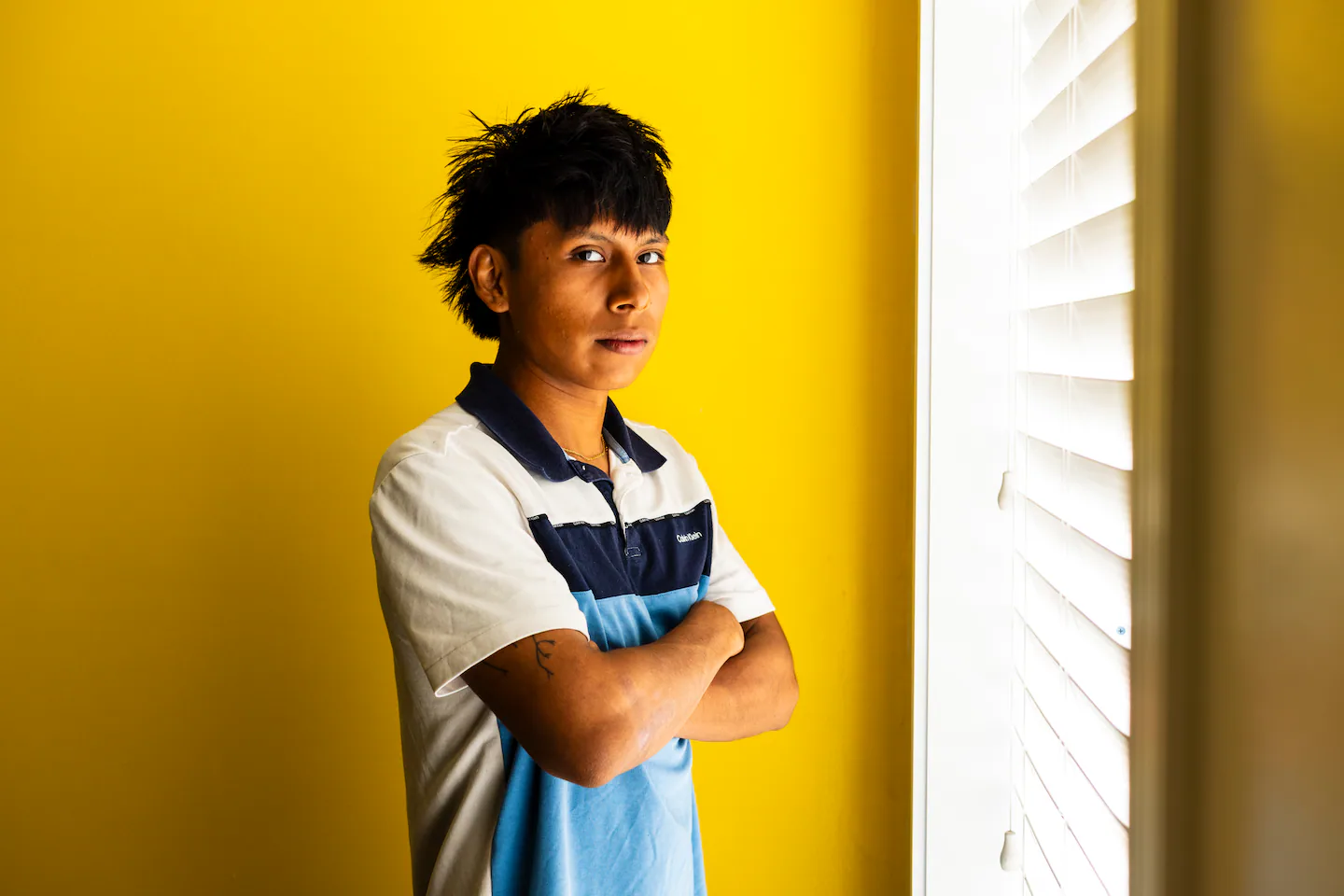
How many US citizens have been swept up in the Trump administration’s immigration sweeps is challenging to say. No comprehensive log of such encounters is available from the federal government, and immigration agents are not required to document stops of citizens.
A review by The New York Times of publicly reported cases and court records found that since January, at least 15 US citizens have been arrested or detained and questioned about their citizenship by immigration agents or local law enforcement officers enlisted to work with federal authorities.
In late January, Julio Noriega, 54, of Chicago, had been handing out copies of his résumé to local businesses in Berwyn, Illinois, when ICE officers approached him as he walked out of a Jiffy Lube auto service shop.
They handcuffed him and loaded him into a van, without allowing him to explain he was a citizen, according to a motion filed in the US District Court for Northern Illinois. He was released about 10 hours later, according to the court filing.
Kenny Laynez-Ambrosio, 18, was born and raised in West Palm Beach, Florida, where he lives with his mother and two brothers.
He was on his way to work with his mother and two friends in May when troopers from the Florida Highway Patrol stopped them in their employer’s pickup truck for what the agency said was a “commercial motor vehicle inspection.” Initially, Laynez-Ambrosio was calm, he recalled in an interview. But the situation escalated as troopers learned that others in the car were in the country illegally and ordered everyone out.
When no one got out of the vehicle, the troopers began to pull the three men out. At one point, a trooper fired a Taser at one of them.
Laynez-Ambrosio, recording on his phone, repeatedly told the officers, “I’m from here!”
“You’ve got no rights here. You’re illegal, brother,” a trooper is heard saying. In Florida, a new state law requires all local and state law enforcement agencies, including the Highway Patrol, to participate in immigration enforcement.
All three men were taken to a nearby Border Patrol facility, and though Laynez-Ambrosio continued to say he was a citizen, he was held there for about six hours.
Asked about the US citizens identified by the Times, the Department of Homeland Security defended its actions as “highly targeted.”
“If and when we do encounter individuals subject to arrest, our law enforcement are trained to ask a series of well-determined questions to determine status and removability,” Tricia McLaughlin, a department spokesperson, said in a statement.
Federal officers’ tactics continue to be a source of contention in the courts. This summer, the American Civil Liberties Union filed a lawsuit against the federal government, arguing that the roving patrols are targeting Latinos and violating the Fourth Amendment, which protects against “unreasonable searches and seizures.” A federal judge in Los Angeles ordered a halt to stops based on a person’s apparent race or ethnicity, or other factors that suggest they are Latino, such as speaking Spanish or accented English.
But this month, the Supreme Court put the order on hold. The lawsuit will still make its way through the lower courts and may end up back at the Supreme Court. In the meantime, federal agents in and around Los Angeles will not be constrained by the lower court’s finding that such stops were unconstitutional.
Immigration enforcement agents have for decades focused on workplace raids or targeted immigrants in the country illegally to arrest them for deportation. But during some immigration sweeps in heavily Latino communities, particularly in Southern California, federal agents have roamed the streets, courthouses, and workplaces demanding proof of citizenship from residents. The roving patrols and impromptu interrogations have been a striking departure from the understanding that the Constitution allows citizens to remain silent and places limits on who officers can question, hold, and detain.
As videos of these encounters have spread online, many Latino men and women who are citizens have begun to carry their passports as they go about their daily lives, fearful that they too will be stopped and questioned by immigration agents.
A report by the Cato Institute found that a substantial number of ICE actions have targeted workplaces and neighborhoods that are heavily Latino. One in five of the agency’s arrests has been of a Latino resident with no criminal past or removal order, according to Cato, a prominent libertarian think tank, which analyzed ICE arrest records obtained through the Deportation Data Project.
In upholding a lower-court ruling against the government, the 9th US Circuit Court of Appeals cited the experience of Jason Brian Gavidia, 29, who was born in California, the son of Salvadoran and Colombian immigrants. Gavidia, who refurbishes old cars, was raised in East Los Angeles, where Latinos make up the overwhelming majority of the population.
According to videos of the encounter, interviews, and court records, officers did not identify themselves as they entered his auto business in Montebello, California, in June, masked and with guns drawn. They wrestled another owner, Javier Ramirez, 32, to the ground, holding him at gunpoint, and pushed Gavidia against a fence.
“The agents repeatedly asked Gavidia whether he is American — and they repeatedly ignored his answer: ‘I am an American,’” the ruling stated.
The officers, who were from Customs and Border Protection, an agency of the Department of Homeland Security, took Ramirez away in a van, driving him around for hours before taking him to a federal detention center downtown, according to a statement he submitted to the court. Ramirez did not speak to a lawyer or any family member for three days, he said in an interview.
Asked about the men’s cases, DHS has said that Gavidia interfered with their enforcement operations and that Ramirez assaulted officers. But Gavidia was never charged, and a charge against Ramirez was dropped. Security videos of the incident reviewed by the Times do not show Ramirez assaulting officers.
In several of the cases, DHS officials told the Times that the citizens assaulted officers; prosecutors have not pursued charges in any of those incidents.
As Trump campaigned for reelection, promising to carry out the largest deportation effort in the nation’s history, he often cited as a model a 1950s initiative named after a racial slur, “Operation Wetback.” In the decades since, federal courts have ruled that immigration agents cannot detain people without having a specific, factual basis for believing a person is in the country illegally.
The Supreme Court emergency ruling earlier this month effectively allows agents to stop anyone on suspicion of being an immigrant living in the United States illegally.
The tactics and results have raised questions, even among some who support the administration’s overall approach to immigration.
“If you’re going to be aggressive on deportations in the interior, you cannot make a mistake,” said Daniel Garza, a former police officer who backed Trump and heads the Libre Initiative, a conservative group focused on Latino voter outreach. “If people are being stopped solely because of the way they look, that is a problem.”
Leonardo Garcia Venegas, who was born in Florida, said that in May, he tried to keep going about his work at a construction site in Foley, Alabama, when he saw immigration agents shove his brother, who is in the country illegally, to the floor.
He pulled out his phone to record and was quickly tackled to the ground by other officers, Venegas said. They kept him in handcuffs for hours, claiming his identity documentation was fake, he said. A spokesperson for DHS said that Venegas tried to physically obstruct immigration officers; no charges were filed, and he said he stood filming from several feet away.
More than a month later, at another construction site in Fairhope, he was confronted again, Venegas said. This time, agents didn’t handcuff him, he said, but they again questioned his citizenship, escorted him out, and held him for at least half an hour.
“I cannot work in peace anymore,” Venegas said in an interview. “I am always nervous.”



